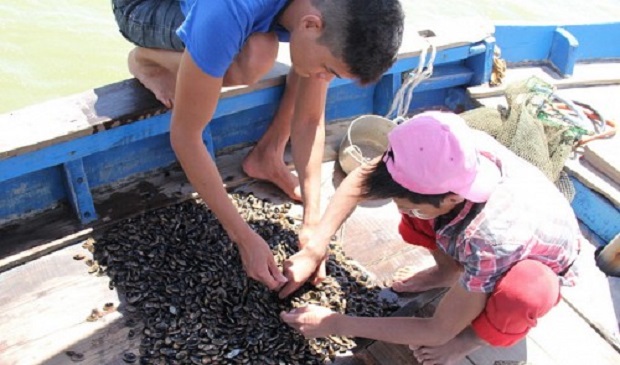Clam hunting in Da Nang
Hundreds of divers flock to the Han River and the Gulf of Da Nang in the eponymous city every day in search of a species of hard-shell clam gaining popularity on city restaurant menus.
 |
| A pile of harvested chip chips on board one of the boats in Da Nang. Tuoi Tre |
‘Chip chip,’ a Vietnamese onomatopoeia for the chirping sounds of birds, is what local Vietnamese call these black-and-white hard-shell clams native to the Han River and the Gulf of Da Nang.
Featured in a variety of Vietnamese dishes that go particularly well with cold beer, chip chips have earned their place in the stomachs of local residents and food-loving tourists, resulting in a boom in the ‘chip chip’ diving trade.
As these clams normally hide themselves under muddy riverbeds, divers must submerge themselves by up to eight meters and use gloved hands in search of their prey.
Tuoi Tre (Youth) newspaper reporters hitched a ride on one merchant’s motorboat to witness first-hand the growing business happening day and night on the Han River.
Under the scorching heat of the mid-July sun, hundreds of motorboats, shielded from its rays by nothing more than worn-out sheets of cloth, come gradually into sight as their boat approaches the middle of the river.
The cash cow
Tran Be, the oldest trader, sits by himself on one of the anchored boats.
“The rest are down there,” Be says, pointing at the oxygen cylinders connected to a ventilator on the boat, their other ends submerged in water. “I’m up here alone to keep watch.”
The waterway is dominated by the sounds of diesel engines mixed with sirens warning approaching ships of the submerged oxygen tubes.
Be reveals that he is sixty years old, having been in the business for four years after retiring from his offshore fishing job.
Too weak to dive, Be’s main task is monitoring the oxygen tubes and ventilator to ensure they function smoothly and do not catch on other boats’ propellers.
The job earns Be VND100,000 (US$4.46) a day, which can fluctuate at the height of the hunting season.
About ten minutes later, Be springs to his feet and starts pulling up one of the tubes after water bubbles appear on the right-hand side of his boat.
From the water emerges Tran Van Duoc, one of the chip chip divers, with a bag of harvested chip chips in his hand.
Taking a drag out of a cigarette to warm himself, Duoc expresses his frustration as he weighs his bag of clams, “I can hardly see anything in this water; it’s too muddy.”
Duoc, 23, is the least experienced diver aboard, having worked in the business for only two months. He makes VND2 million ($89) a day by collecting 30 to 50 kilograms of clams.
Duoc’s earnings translate to a $32,600 annual tax-free income, a high sum when compared to Vietnam’s average wage of around $2,500 a year according to figures by U.S.-based financial research company Standard & Poor’s.
But Duoc’s income seems small compared to that of Be’s son-in-law Tran Thanh Hung, the owner of the boat, who makes up to VND7 million a day from the business.
According to Hung, making money with the job is not a problem as long as one is not afraid to get dirty and exhausted.
 |
| A chip chip hunting motorboat on the Han River in Da Nang. Photo: Tuoi Tre |
Conserving nature’s treasure
According to Nguyen Tu, head of a local diver association, the chip chip species has been present in the river for around ten years, but the hunting trade did not develop until over four years ago when a nearby shipyard was relocated elsewhere.
As more tourists flock to Da Nang, the price of chip chips has also surged, drawing divers from across Viet Nam to the area in the hope of claiming their share in the flourishing business.
Despite constant harvesting, the population of the clam species never seems to run out, as all divers follow the unwritten rule of collecting only grown chip chips and leaving the small ones for repopulation.
Nguyen Thien, a diver with 20 years of experience in the job, said there had only once been a fleet of boats using fine-meshed nets to sweep the riverbed, resulting in the temporary removal of the species for the next couple of months.
Since the incident, Thien said, divers in Da Nang have agreed to use only their bare hands to collect chip chips.
According to the aquaculture authority of Da Nang, the minimum harvestable size of chip chips is 30 millimeters.
(Source: Tuoitrenews)